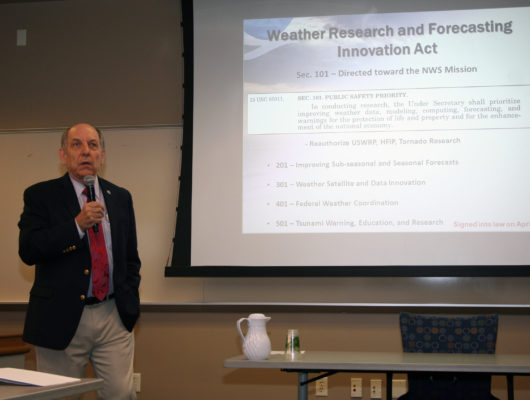The Weather Act of 2017
The Weather Research and Forecasting Innovation Act of 2017, signed into law on April 18, is a sweeping and detailed plan of improvements and advances aimed at strengthening the National Oceanic and Atmospheric Administration’s (NOAA) weather warning and forecasting, and improving cooperation among government agencies, research institutions, and industry.
Last week, University of Wisconsin-Madison alumnus and NOAA National Weather Service (NWS) Director Louis Uccellini was in Madison to update academics, industry representatives, and agencies about the scope of the law and what it means to the nation’s weather enterprise.
In 2012, Uccellini established a roadmap for the Weather Ready Nation (WRN) program that tasked the weather community with better linking forecasts and warnings to decision-making at agency and local levels, but now, says Uccellini, “our public safety mission is codified in this law for the first time, providing connecting points we should be excited about.”

National Weather Service Director Louis Uccillini speaking at the 2017 annual NWS Partners meeting in Madison, WI on the impacts of the new 2017 Weather Act.
According to Uccellini, this is the first time legislation specifically mentions the American weather industry, an important step. “What we do affects lives, property and commercial and insurance aspects of this country,” he says. The forum included discussion about the role of the NWS, how far its role extends, where opportunity for private industry to contribute data and products begins, along with the government’s role in assessing those data and products moving forward.
Uccellini provided an update on WRN progress to date, covering observing systems, dissemination infrastructure, computing, GOES-16, the role of social science in decision-making, and status of the WRN ambassador program.
The NWS is studying infrastructure across the country to make sure that the U.S. can continue to make surface observations into the future, from the radiosonde network to the Automated Surface Observing System sensors, many of which are located at airports, serving meteorological and aviation needs. The automatic observing network, says Uccellini, is “going to be a driver for what we do” because of the looming importance of predicting ice.
In an effort to avoid data outages, the NWS has undertaken a massive upgrade of its computing infrastructure with the final increase to be online by January 2018. Upgrading and backing up the IT dissemination networks, improving networking services, and weather information distribution, are central to avoiding failures in the future.
GOES-16, says Uccellini, will be integrated into work routines across the NWS, from observations to facilities improvements to forecast analysis and support. Data from GOES-16 “is redefining mesoscale meteorology because we can now view a level of detail and frequency” not possible with earlier satellites.
As the NWS improves the decision-making, messaging, and public responses to those messages, Uccellini notes the importance of involving social scientists who study the complexities of human behavior. This is the challenge: how do you convince people that outrunning a storm may be a dangerous proposition or make sure they take a NOAA weather radio when traveling out of cell phone range? There are significant areas across the U.S. where cell phone coverage may be patchy or non-existent, where warnings may not be received, but the range of the NOAA radio ensures that alerts will be available to be heard. Social scientists can help with the nuances of crafting a message, in a time window that is not too large, to which the public will listen.
The NWS is building relationships and creating partnerships through the WRN ambassador program – now with 5,900 ambassadors across the country – in an effort to distribute accurate and consistent messages about forecasts and warnings.
The Weather Act did not influence the 2017 NWS budget, nor does the President’s proposed budget for 2018 reflect what is in the bill. “Authorization bills are only good if they are used. This will be the challenge for us as a community,” says Uccellini.
by Jean Phillips
